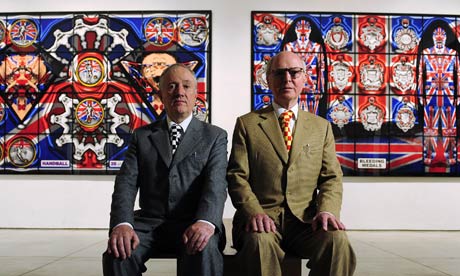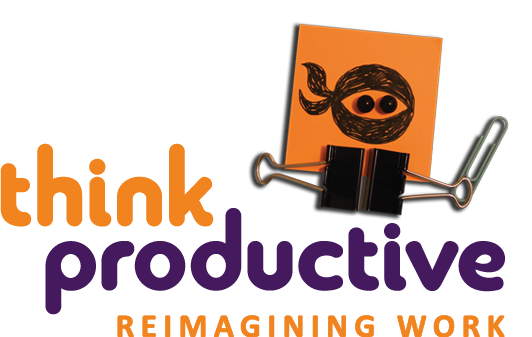![]()
Lessons about productivity can be found in the most unusual of places. Gilbert & George are artists renowned for being controversial, shocking and eccentric but also for being groundbreaking and innovative. In a recent interview with Mark Lawson on BBC Four, I found several things to be inspired by. So, here are five productivity lessons from Gilbert and George!
1. Don’t waste time on things you don’t care about
GEORGE, talking about why they always wear matching suits:
“We just want to devote ourselves to art. We’re all dragged at increasing speed towards the grave. Any picture we don’t make will be not made by somebody else. So we don’t need to go shopping, we don’t have to cook. Everything’s based on having a very simple life, including the tailoring. We don’t have to change style every three years like the boys in the city. It’s always the same style and very simple. The shirts we buy every three years, they’re always white. Ties we only wear the ones we’re given as presents. It’s a very very simple life devoted to art.”
If you know Gilbert and George, you’ll know they’re almost as famous for their suits as they are for their work. This is really clever: by wearing suits in the 60’s, they stood out in the art world and hence got noticed, but they also use this device to apply limits to their own choices, so that they have more time, energy and focus to spend on the things that matter, like producing art. If you love clothes you may find this absurd. However, I think a lot of us do similar things to this already: all my socks are black so that I never have to worry about them matching, I will often find a pair of trousers I like and buy several pairs and so on. Your attention, time and focus are limited: spend each of them wisely!

2. Keep your head clear
GEORGE, talking about food…
“We go to the same restaurant every evening when we’re not entertaining and we have the same meal, month in, month out until we decide to change it. And then we’ll change it and that will be the same meal every evening until we change our minds again. We don’t like the idea of reading menus or thinking about food. It seems rather a waste of brain to us.”
GILBERT:
“To free up the brain, to use the brain in a special way. Not to be cluttered. To be free people that can think whatever they want”
GEORGE:
“We’ve trained ourselves to clear the head. It’s an extraordinary thing. It feels like a desert in front of us, panning out, which we can do something with.”
I find this really inspiring. They were practising ‘lifestyle design’ long before Tim Ferriss coined the term and have done what they’ve found creative energy, a high level of productivity and contentment through their lifestyle, not through the love of material ‘treats’. Again, if you’re a foodie, this might seem like such a waste, but the most important aspect of this is the way it provides a clear head, much like David Allen talks about in ‘Getting Things Done’.
3. Don’t wait for things to happen, make things happen
GILBERT, talking about art school:
“We went out and created a world for ourselves… The G&G world started when we were stranded outside St Martin’s School of Art, when we left. The moment that you leave school you are alone for the first time. They don’t want to know you anymore. That’s it.
Every day we did something different: like we did the walking sculpture, the singing sculpture, the postal sculpture, the magazine sculpture, the eating sculpture, so every day, creating a world, creating and G&G world, without having to be in a gallery. WE used to say “all the world an art gallery”. We couldn’t be in a gallery but we still wanted to be artists. And we were able to create a totally new world, which was very exciting.”
GEORGE:
“We weren’t like the other students, that’s for sure. They were all intent on becoming artists and working on how to become an artist. We felt we were artists anyway”
Like many of the best entrepreneurs, Gilbert and George have always been audacious: they’ve redefined the boundaries, in their case in particular around what constitutes sculpture and what does not. This confidence and self-belief was fundamental to them getting started, along with arguably, a sense of the fear of the unknown and a fear of failure. On the surface, they were just two regular guys, in the same position as all of their fellow-students, but as they left art school, they made things happen rather FOR them, rather than wait for things to happen TO them.
4. Celebrate accidents!
GILBERT, talking about their move to the east end of London
“We are based on accidents. We like that. Whatever happens happens. Sometimes bad accidents turn out to be extraordinarily good ones.”
Gilbert and George moved to the east end in the 1960’s when it was the cheapest place to live and work (you could live in the same place as you worked, which was only possible in the then-slums of the east end). Of course, in the 40 years since then, the east end property market has changed radically and they did rather well from their investment! But more importantly, their moving to the east end began the definition of the modern art scene. Accidentally, they created the centre of the British modern art movement on their doorstep.
In their work, too, they are not afraid to use accidental effects, blotches and so on to become part of their work (incidentally, this is something they share with one of my musical heroes; Matthew Herbert who has written an excellent ‘manifesto’ that incorporates this idea).
As a culture, we hate failure. So here’s a tip. Learn to celebrate accidents and failures; don’t get hung up about them. Accidents present unusual situations and opportunities if you can get beyond feeling annoyed and stressed that they happened in the first place. It will truly help you identify increased successes and help you be more innovative too.
5. Make your own luck and turn weaknesses into strengths
GEORGE, on their first big break at the “when attitudes become form” exhibition at the ICA:
That was one of the first great chance bits of luck that we had. There was a very famous international touring exhibition called ‘when attitudes become form’ or ‘live in your head’. Wherever it went it the world, the curator from that city was asked to add artists from that city to join the exhibition. It was coming to London, to the ICA and we knew the selector and we knew that we’d be included. Then, to our shock and horror, he DIDNT invite us. We were amazed by that. We were some of the few artists that could be included in that show. And we were rather desperate and downcast about it. We saw it as a missed opportunity. And we thought the only thing we can do about it is to be living sculptures, which we are already. We’ll take ourselves to the private view and be living sculptures. And we went to the private view with our hands and heads covered with multi-coloured metalized powders and stood stock still in the middle of the opening. We stole the show entirely. And at the end of the evening, a young man came and said “I am Conrad Fisher. You’ll do something with me in Dusseldorf” He was the most famous art dealer of his age and it was an invitation that every artist would die for at that time. We went to Dusseldorf and were a huge hit”
Samuel Goldwyn, founder of the entertainment giant MGM once said “the harder I work, the luckier I get”. I often hear successful people talking about being ‘lucky’, but if you read between the lines and think about all the self-belief and hard work that was ALSO involved to create those lucky break moments, you’ll see how valuable this lesson really is.
Gilbert and George reframed the problem from “we’re not invited”to“how we COULD be there to exhibit and get noticed”. The execution of the idea was probably relatively easy, but the courage, ingenuity and confidence required to stand out and tackle their own problem rather than go with the flow is rarely easy.
So what can you take away from eccentric artists who make pictures using swear words and their own bodily fluids? Well, actually quite a lot!
Manage your attention and focus ruthlessly, don’t keep anything in your head that you don’t have to, don’t hang around thinking things will ‘just happen’, celebrate your failures and accidents, identify opportunities, turn your weaknesses into strengths, be audacious and have confidence in your abilities.
Good luck!
